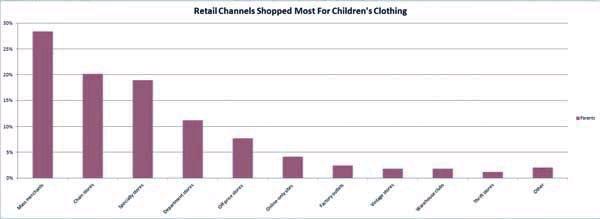The kids have it:Parents will pay more for unique, quality kids clothesn
2015-02-06byZhengRan
by+Zheng+Ran
Nothing in this world is certain but death and taxes — and kids outgrowing their clothes. Its a steady market that has replenishment built right in. However, despite the short wear time, parents dont want cheap disposable fashion. Rather, theyre willing to spend a little more for their little ones – from the time theyre being diapered (yes, parents do care about their childs baby wipes) right through the tween years.
“Most parents are concerned that clothes are suitably tested for wear and tear, especially for purchases such as school wear and outerwear, etc.,” says WGSNs trend expert Ellen Kirkhope, head of kidswear.” Most parents would probably pay a small premium for guaranteed performance.”
According to Cotton Incorporateds Lifestyle Monitor? Survey, about 9 in 10 parents say quality (92%) and durability(89%) are important to their childrenwear purchases. (Picture 1)
Research from the Monitor? indicates that 84% of parents prefer their children to be dressed in cotton because they feel cotton clothing is the most comfortable (68%), breathable (67%), and durable (57%). This may be why 1 in 2 parents say they are bothered by fiber substitutions away from cotton in their childrens clothing and more than 6 in 10(63%) are willing to pay a premium to keep their childrens clothes cotton-rich.
The 2014 U.S. childrenwear market is expected to reach almost $55 billion in sales, according to Market Line. Meanwhile, a report from Data monitor forecasts the years worldwide childrens apparel sales will reach $186 billion. The luxury market – where parents might spend upwards of $700 for a holiday dress – will account for $29.6 billion of the global childrens market, according to an account in the New York Post.
Like the rest of fashion, the kidsmarket can tell the tale of two shoppers: the parent who will spare no expense to keep his or her child looking fab, and the parent who wants good clothes – within a budget.
The Doneger Groups Patty Leto, senior vice president, merchandising, says while the upscale customer isnt concerned with the expense, most other shoppers generally look for price, novelty and fashion, and quality.
“In addition to the obvious difference of cost between markets, high-end consumers look for exclusivity of brand or product, quality and forward fashion merchandise,” Leto says. “I think that both the mainstream and mass customer is sensitive to price and looks for strong price/value product. Styling at all levels will always be the key.”
TuTu Spoileds Jessica Snarski, owner of the childrens boutique and ecommerce site, says her shop caters to the fashion forward parent that wants to keep her child looking trendy in well-made clothes.
“The parents here all want outfits that they know wont shred to pieces. Theyre looking for good quality and theyre willing to pay for that,” Snarski says.
WGSNs Kirkhope says the average person is looking for practicality and washability.
“Many designer items will use premium fabrics for hand feel and finish, but theyre not practical,” she says, remarking on the differences between the customer levels. “The market is quite split. Brands between mass market up to midlevel tend to be more child-focused and fun. Designer and high-level brands go for ‘mini me looks.”
When shopping for school clothes, 47% prefer to buy more fashionable items for their kids than wardrobe basics, the Monitor? survey finds. More than half(54%) are looking for the best quality at the best price. The remaining 26% have an extremely practical outlook: these Monitor? survey respondents say they want the best price because “my child or children are just going to destroy the clothes or grow out of them before the school year ends.”
Snarski says most of TuTu Spoileds shoppers fall into the fashion-minded category. They dont mind paying boutique prices, “as long as their child is wearing something different and unique. Even if theyre just buying it to wear for school pictures, they want something unique thats top quality.”
Parents want that top quality when it comes to pampering their babys bottom as well. Nearly half of all parents are also willing to spend more for cotton baby wipes, according to Cotton Incorporateds 2012 Baby Wipe Survey. Further, 3 in 4 parents said they prefer their wipes be made from cotton, saying cotton wipes perform better than non-cotton (wood pulp, polypropylene, etc.) in terms of being healthy for babys skin (60%), soft(60%), sustainable (58%), comfortable(56%), and non-toxic (51%).
Snarski said, “We have customers that prefer to shop in-store because they want to see and feel the clothes and their quality, or have their kids try them on,”she says. However, some know the specific brand and what theyre looking for so they just purchase it online. For some with small kids, its just easier to shop online than to drag them into a store.”
The Monitor? finds that parents say they typically purchase about 80% of their childrens clothes in-store and 20% online. Top retail channels shopped include mass merchants (28%), chain stores(20%), specialty store (19%), and department stores (11%). (Picture 2)
Kirkhope says online shopping for children is still a growing market, led by designer brands. “Its definitely an area to watch.”
